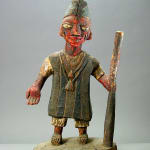Yoruba Polychrome Sculpture of an Oba, 20th Century CE
Painted Wood
X.1048 (LSO)
Further images
This striking piece is a representation of an Oba, the hereditary kings of the Yoruba polity. His status is denoted by his long striped tunic, his insignias around his neck,...
This striking piece is a representation of an Oba, the hereditary kings of the Yoruba polity. His status is denoted by his long striped tunic, his insignias around his neck, and the high, ornate crown. The right hand is extended palm-outward, implying welcome and friendship. He holds a tall staff in his left hand. His face is marked with the triple cheek scars that denote most Yoruba art. He wears a slightly smiling expression, emphasised by his heavily lidded, white-painted eyes.
The Yoruba peoples of Nigeria have what is probably the longest extant artistic tradition in Africa. The nation state is comprised of numerous subsections that were joined historically by the rise and collapse of the Ife (12th to 15th centuries) and Benin (13th to 19th centuries) polities. Each of the sub-kingdoms – including Oyo, Ijebu and smaller units towards the west – had their heyday, and are loosely united through language and culture, although they still retain a measure of independence in terms of artistic tradition. It is extremely hard to summarise the nature of Yoruba society given the large area they cover and the inevitable variability of their customs.
The Yoruba – being a large, complex society – is sedentary, agriculturist and hierarchical. They are ruled by hereditary kings known as Obas, and their access to the supernatural world is supervised by a very complex arrangement of priests (i.e. Olowa) and spiritual intermediaries. They also have a deeply established aristocracy and social order, which is reflected in Yoruba artworks.
This is a representation of an elite personage, and is a truly impressive piece of African art.
The Yoruba peoples of Nigeria have what is probably the longest extant artistic tradition in Africa. The nation state is comprised of numerous subsections that were joined historically by the rise and collapse of the Ife (12th to 15th centuries) and Benin (13th to 19th centuries) polities. Each of the sub-kingdoms – including Oyo, Ijebu and smaller units towards the west – had their heyday, and are loosely united through language and culture, although they still retain a measure of independence in terms of artistic tradition. It is extremely hard to summarise the nature of Yoruba society given the large area they cover and the inevitable variability of their customs.
The Yoruba – being a large, complex society – is sedentary, agriculturist and hierarchical. They are ruled by hereditary kings known as Obas, and their access to the supernatural world is supervised by a very complex arrangement of priests (i.e. Olowa) and spiritual intermediaries. They also have a deeply established aristocracy and social order, which is reflected in Yoruba artworks.
This is a representation of an elite personage, and is a truly impressive piece of African art.









